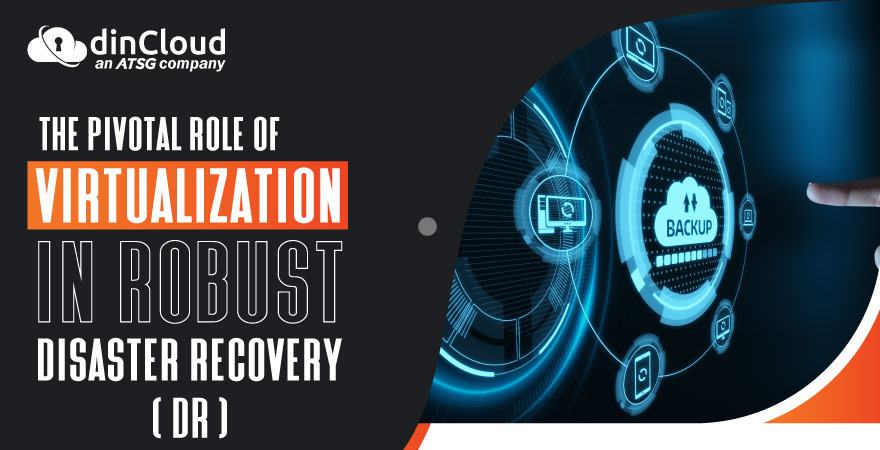Enterprise operations are becoming heavily reliant upon digital technologies. As the “digital footprint” of enterprises increases, so do the accompanying challenges of setting up efficient, robust and secure IT infrastructures.
Not long ago, businesses used to invest in IT infrastructures and digital technologies with one major priority, which was to prevent a disruption in the first place. However, recent incidents and trends have proven this orientation to be away from the ground reality.
Fact of the matter is, there are too many different factors at play that can potentially disrupt the smooth functioning of enterprise operations. Secondly, present day IT infrastructures are subject to a wide range of cyber security challenges.

In view of the above, organizations need to view their security postures in a completely different context. The main aspect to reconsider is that disasters and disruptive events are inevitable. So, instead of a “preventive” approach, a “risk mitigation” mindset is needed.
The Journey from Disaster Prevention to Risk Mitigation
As soon as enterprises move away from the traditional, “preventive only” mindset, they actually begin their journey towards setting up a robust Disaster Recovery (DR) posture. This approach to disasters and disruptive events is “all-encompassing”.
Once an enterprise has decided in principle that its IT infrastructure needs a formal Disaster Recovery (DR) strategy and mechanism in place, then begins the equally important phase of setting up a DR plan and seeing it through till implementation.
There are a wide range of DR strategies and courses of action. Every organization needs to pursue the DR plan that best aligns with the existing and future Disaster Recovery (DR) needs of the specific organization.
In this post, we will highlight the role of Virtualization in resurrecting a robust Disaster Recovery (DR) posture, and the benefits of using it as well.
What is Virtualization?
Restricting ourselves to the most “layman” definition of Virtualization, it is the ability of an organization’s IT professionals to leverage different IT resources from a single piece of physical hardware.
A pertinent question here would be, how is that even possible? Well, the answer to this question lies in specialized software resources, which enable IT admins to change the “state” of the underlying hardware, as and when it is required.
Now, let us cover some of the most common types of Virtualization, and which one would be suited for what sort of a use case scenario.
Storage System Virtualization
This type of virtualization is pursued by organizations that have highly valuable, or sensitive data with them. In the case of storage system virtualization, a “virtual clone” / back-up is created for the data. The intervals at which data is virtually replicated will vary though.
Related Posts:
- How to Navigate a Cloud Based Disaster Recovery (DR) Strategy?
- Your One Stop Guide to Disaster Recovery (DR)
- A Cloud First Disaster Recovery (DR) – The Way Forward
- Why you need Cloud Business Continuity and Disaster Recovery?
Operating System Virtualization
Striking the balance between functionality, resources and costs is really important for businesses. Keeping in view the above needs, enterprises tend to create the “perfect blend” of the Operating System (OS). This type of virtualization really helps in large entities.
Server Virtualization
This virtualization strategy for Disaster Recovery (DR) is pursued by organizations that have very time sensitive workloads, processes or information to back-up. As soon as the IT resources face a disruption, cyber attack or extraordinary load, servers are replicated.
Hardware Virtualization
This type of virtualization involves splitting a large chunk of physical IT hardware, into much smaller capacity IT resources that could be storage, compute, processing, RAM or more. This type of DR strategy focuses mainly on the deficient IT resources.
Now that we have touched upon the most common types of virtualization, let us discuss the benefits of incorporating virtualization in the Disaster Recovery (DR) plan of an enterprise.
Improved Resilience
Most disasters or disruptive scenarios befall organizations without any major early warning. In an era where downtime of even a few minutes is not affordable, virtualization improves the resilience of an organization to remain fully up and running, or at least partially.
Reduced Downtime
Unlike physical hardware resources for Disaster Recovery (DR), virtualized resources are quick, easy and agile to spin-up, and then deploy. This agility provided by virtualization goes a long way in reducing the overall downtime, in the event of a disruptive event.
Lower Operating Costs
DR systems, whether hardware based or virtualized, accompany their fair share of costs as well. Virtualized DR systems, unlike hardware based ones, have much reduced overhead costs, resulting in the overall cost optimization of the enterprise.
Quicker Provisioning of Affected Resources
It is very difficult for enterprises to presume which exact part of the infrastructure will face the disruption. Virtualization enables IT admins to spin-up and deploy the specific IT resources that are scarce, instead of replicating every IT resource, even if not needed.
Better Customer Experiences
Today’s customer does not tolerate even the slightest of disruption or downtime. Virtualization provides enterprises the much needed flexibility, resilience and resources to execute a DR plan that is both efficient and feasible.
Conclusion
Disruptions are an inescapable reality of the present day business landscape. The more pertinent question is, how well prepared is an enterprise to confront such a disruptive event, and ensure that all mission critical processes and workloads remain unaffected.
Contact dinCloud, an ATSG company, for top notch Cloud Hosted Virtual Desktop solutions that come with a robust Disaster Recovery (DR) posture built-in.


